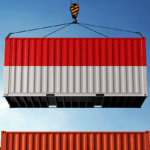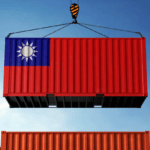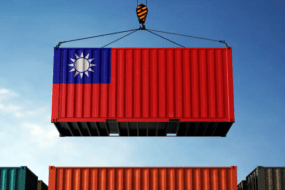- Home
- Trade News
- Indonesia Exports: Sunny Outlo ...

At first glance, the outlook for Indonesia’s exports in 2025 might seem clouded. Thermal coal, long one of Indonesia’s main exports, is under pressure as major buyers like China and India turn down the dial.
Meanwhile, across the Pacific, US tariffs have dealt a blow to the country’s garment sector, raising questions about the resilience of Indonesia’s economy in the face of shifting global tides.
Yet, look a little closer, and a more complete picture emerges. Far from retreating, Indonesia is quietly rewriting its international trade, diversifying export partners, targeting zero-tariff deals, and embracing sectors beyond natural resources.
In short, while some traditional engines are slowing, the total value of exports from Indonesia may be on track for a fresh resurgence.
Indonesian Coal Exports Facing Difficulties
Only a few years ago, Indonesia was riding high on global demand for mineral fuels, particularly thermal coal. But in 2025, that tide is turning.
Recent trade statistics show a notable dip in coal shipments due to slowing demand from key buyers like China and India. Both countries have started investing more heavily in alternative energy sources while scaling back imports amid price tensions.
This trend is not just temporary. Chinese customs data shows a 26% drop in coal purchases from Indonesia in Q1 2025, and India’s state-owned importers have been quietly cancelling tenders.
Coal accounts for a major slice of Indonesia’s total exports, so this shift matters for export value and the broader national economy.
Energy Export Plans to Singapore
To that end, Indonesia is already moving towards cleaner exported goods. This May, state-owned Pertamina NRE announced plans to build a solar panel production facility to support renewable energy exports to Singapore.
This marks a pivot away from non-renewable resources like crude oil and coal, and towards a broader economic growth strategy built on clean energy.
The proposed cross-border project, which could begin construction later this year, reflects how Indonesia is repositioning itself in Southeast Asia’s evolving energy landscape.
If successful, it may pave the way for greater exports of sustainable tech and materials, which are in high demand in international markets.
Tariff Troubles for Indonesian Garment Exports to the US
The shift from natural resources to manufactured goods hasn’t been without its hurdles. Indonesia’s most pressing economic issue is the sudden spike in US tariffs on garment exports.
Starting Q2 2025, Washington has implemented higher duties on textiles from select countries, including Indonesia, citing trade imbalances and local industry protection.
The timing couldn’t be worse. With the global fashion industry still recovering from the effects of inflation and shifting consumer habits, Indonesian manufacturers hoped to rely on consistent export markets like the US to stabilise income.
The government has responded with diplomatic efforts, including outreach through the Chamber of Commerce and Industry (Kadin) and exploratory discussions with American trade reps. Still, Indonesian textile exports to the US remain uncertain without formal agreements.
Indonesia Working on Zero Tariffs for Trade With Europe
In contrast to the trouble with the US, Indonesia is making more headway in Europe. A major free trade agreement with the European Union is reportedly in its final stages, with both sides aiming for ratification before the end of 2025.
If successful, the deal could eliminate tariffs on up to 80% of Indonesia’s main exports—including palm oil, natural rubber, and processed vegetable fats.
The implications are significant. With many European economies looking to diversify away from Chinese suppliers, Indonesia could position itself as a viable, lower-cost alternative.
Combined with its large labour force, rich natural resources, and improving compliance with ESG standards, the country is becoming more appealing to European buyers.
More importantly, the EU deal could inject fresh momentum into sectors struggling under US tariffs, allowing exporters to regain ground through international markets that are still very much open to Southeast Asian goods.
Indonesia To Boost Exports to Japan
While Western markets present opportunities and obstacles, Indonesia looks eastward to deepen ties with longstanding partners like Japan.
Tokyo will have emerged as a promising growth area for Indonesia’s exports, particularly in two fast-rising sectors: renewable energy materials and agricultural products.
Indonesia is currently positioning itself as a key supplier of raw materials used in green energy infrastructure, such as nickel and cobalt, both critical for battery production.
Japan’s aggressive push towards decarbonisation means it will require a stable source of such materials. As one of the largest producers of nickel globally, Indonesia is well placed to benefit.
But that’s not all. Japan is also importing more food staples and processed goods from Southeast Asia. Indonesia’s agriculture sector, especially palm oil, cocoa, coffee, and tropical fruits, is gaining momentum.
Exporters are now targeting niche markets in Japan that value organic, fair-trade, and sustainable sourcing. If trade barriers remain low, Indonesia’s export product list could expand beyond mineral and energy commodities.
Russian Support for Indonesian Agriculture
While Russia may not be a traditional trade partner in the ASEAN space, ties between Jakarta and Moscow are strengthening, particularly in agriculture and food security.
Russia has pledged to support Indonesia’s agricultural exports through investment and bilateral cooperation. Recent discussions have revolved around improving local sugar production and supporting palm oil-based biofuel initiatives. But more interestingly, the support goes both ways.
Russia To Export to Indonesia
In the first half of 2025, Russia increased its exports to Indonesia, particularly meat and wheat, commodities that Indonesia has often struggled to source in sufficient quantities locally. Given Indonesia’s growing population and rising consumption, these imports are timely.
Russia’s wheat shipments to Indonesia surged nearly 40% compared to a year earlier, as part of a broader effort to supply natural resources and agricultural commodities to emerging markets in Southeast Asia.
Meat exports, mainly beef and poultry, have also seen growth. These are often at more competitive pricing compared to traditional suppliers.
While this relationship might not dramatically shift Indonesia’s net exports, it reinforces its broader objective of securing reliable trade partners while maintaining a strategic balance across import-export flows.
Indian Rice Exports for Indonesia
Once cautious about rice exports due to domestic shortages and inflation, India has resumed outbound shipments. Indonesia is one of the first markets to benefit.
While this is an import, not an export, it reflects an important trade dependency and reveals the limits of Indonesia’s goal to be food self-sufficient by 2025.
After all, even as Indonesia boasts growing agricultural export value, it still relies on external partners like India to meet domestic staple demand.
India’s Resumed Rice Shipments Offer Strategic Support
After months of export restrictions to protect its food supply, India’s decision to resume rice exports has offered timely relief for Indonesia. With domestic prices creeping up and stockpiles running low, the move has helped Jakarta secure crucial supplies while buying time to strengthen local production.
Indonesia Balances Agricultural Ambitions with Import Reality
Although Indonesia continues to grow its agricultural export base, its reliance on Indian rice imports underlines the persistent gap between production goals and food demand.
This contrast highlights how efforts to achieve national self-sufficiency still require external support in the short term, especially for staple goods.
China To Export Coal to Indonesia
Now, here’s a twist you don’t see every day: China, a top importer of Indonesian coal in previous years, is exporting it back to Indonesia. Though current volumes are limited, the move reflects changing supply chain pressures and hints at gaps in Indonesia’s domestic coal mix, particularly for industrial use.
At the same time, China is increasing its exports to Indonesia in other areas, including manufacturing components, electrical equipment, and finished goods. As Indonesia expands local infrastructure and factories, sourcing from China remains a practical choice—if not a strategic one.
Chinese Coal Shipments Reflect Shifts in Industrial Needs
China’s ability to offer excess coking coal at low prices highlights Indonesia’s evolving energy demands. Despite being the world’s largest thermal coal exporter, the country still relies on niche imports to meet specific industrial requirements.
Chinese Manufacturing Inputs Support Local Expansion
With infrastructure and manufacturing development high on Indonesia’s agenda, imports from China, from parts to full products, fill a growing supply gap. This reinforces Indonesia’s dual role as exporter and consumer within the regional trade network.
Broadening Export Momentum Across Asia
Beyond its traditional trade corridors, Indonesia is gradually expanding its reach across regional partners, including South Korea, Malaysia, and the Philippines.
According to recent export data, shipments to these countries are growing steadily, particularly in electrical machinery, services, and industrial supplies, now among Indonesia’s top exports.
While such articles still represent a smaller percentage share of total exports, they play a more significant role in strengthening the country’s economic performance.
A diversified portfolio of major exports contributes positively to gross domestic product and helps moderate the unemployment rate by boosting domestic industries aligned with external demand.
Conclusion: Strategic Shifts Amid Trade Pressures
So, is the outlook for Indonesia exports all sunshine? Not quite, but it’s certainly not all storm clouds either. Yes, demand for coal is sliding, and yes, the US tariffs on garments are a real headache. But what’s more interesting is how quickly Indonesia is learning to pivot.
All told, these moves illustrate how Indonesia is deliberately managing its international trade position, seeking to protect Indonesia’s exports while navigating global shifts. Though hurdles remain, this multi-directional strategy strengthens Indonesia’s economy, ensuring resilient growth accelerated by emerging opportunities.
At TradeDataPro, we’ve closely monitored these developments to provide deeper insights into the forces shaping export markets across Southeast Asia and beyond. Visit us today for more data-driven trade stories or understand how shifting demand, policy, and partners affect total exports.








